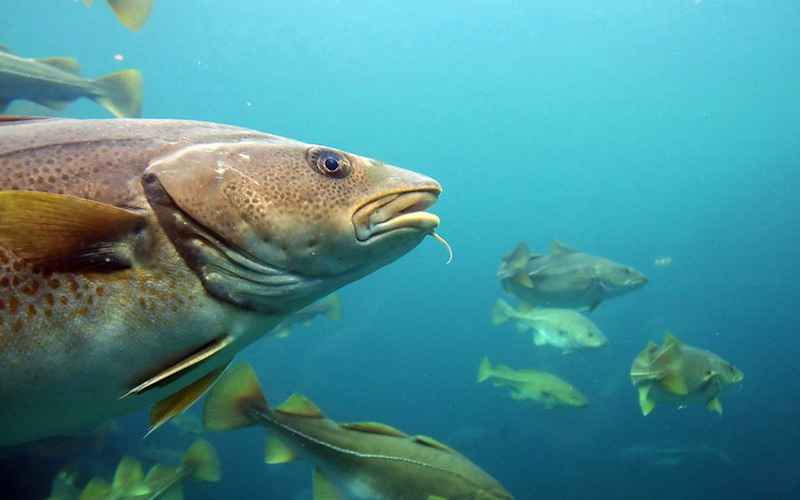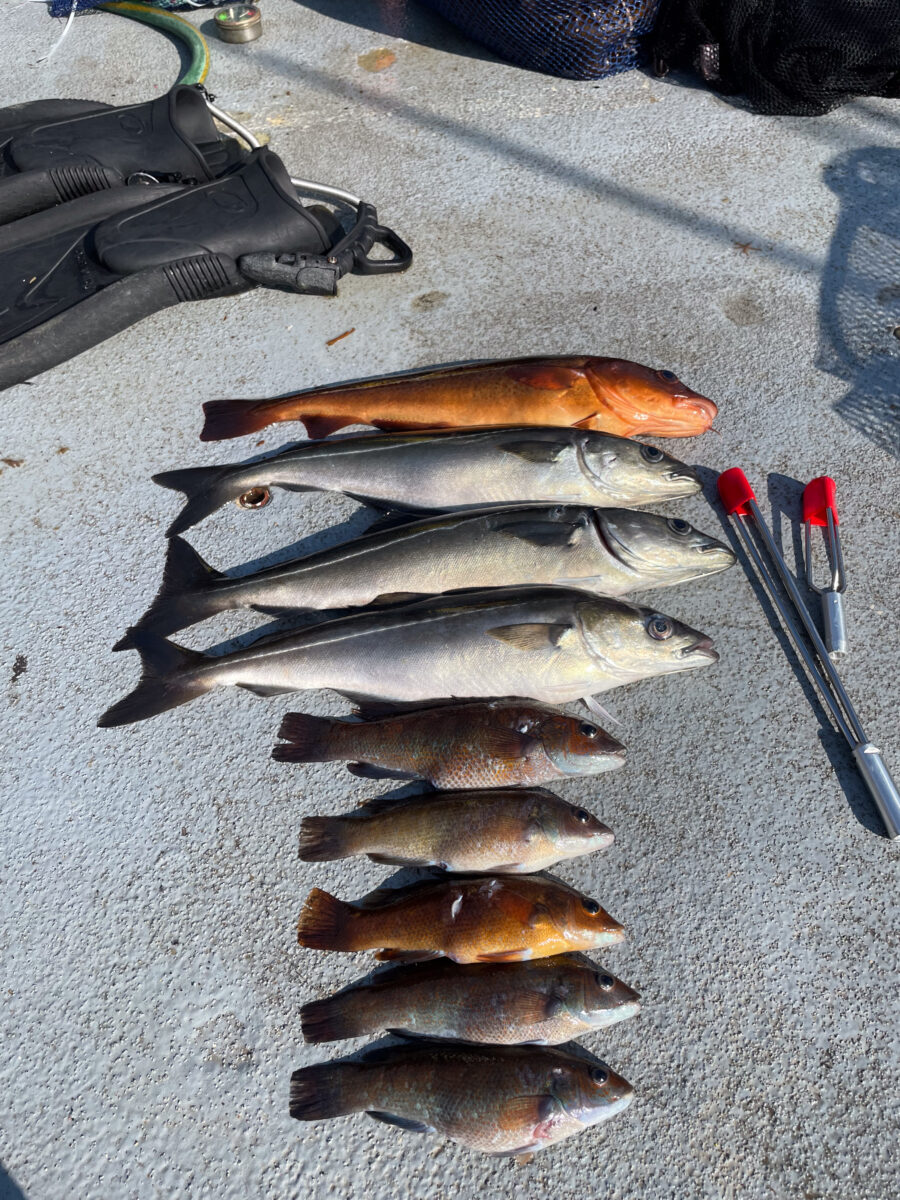
Overfishing hurts iconic species like Atlantic cod – and the coastal economies that depend on them. Photo: Joachim S. Muller
This post was originally published April 2023 and updated March 2025.
For many, the word “overfishing” sparks a particular image: a boat carelessly hauling tons of fish out of the ocean. But this visual fails to paint a complete picture. The actions of an individual boat do not cause overfishing. It’s a systemic problem in which a particular type of fish is caught faster than it can replenish its population.
The good news? Solutions exist to end overfishing. The federal government is responsible for ensuring that overfishing does not occur and that our fishing is sustainable. We need federal agencies to take bold and immediate action to save our ocean resources – and hold them accountable when they don’t.
What Is Overfishing?
Simply put, overfishing means catching fish faster than they can reproduce. If overfishing of a population continues unabated, it can lead federal fisheries managers to declare it overfished – meaning that it has fallen below a healthy, sustainable population level.
As of the last quarter of 2024, in New England, NOAA Fisheries lists 14 fish populations as overfished in its report on the country’s commercial and recreational fisheries. That’s more than any other region in the country. Among them are herring, witch flounder, and the iconic Atlantic cod. Of those 14, overfishing continues for three populations, including Atlantic cod.
Overfishing spells bad news for coastal communities whose livelihoods depend on healthy fisheries. It also affects marine wildlife – such as puffins, sharks, and whales – that rely on these fish for sustenance.
How Did We Get Here?
Overfishing has long been an issue in New England fisheries. Fishing was the first major commercial enterprise of English colonies in the area. Early colonists bragged of cod the size of grown men and claimed they could fish by simply dipping a basket in the water and scooping up dinner. Where Indigenous tribes once fished sustainably for sustenance, English settlers turned the natural resource into an industry.
Those early fishermen couldn’t imagine fishing cod or another species to the point of extinction. Starting in the 20th century, dramatic improvements to ships and fishing technology increased fishing yields exponentially. The arrival of foreign fleets to New England waters in the 1960s and 1970s put even more pressure on fish populations.
The Magnuson-Stevens Act of 1976 ended this freewheeling era, banishing foreign fleets and establishing limits on fishing. Since then, the government and fishing industry have continually wrestled with the question of how to best sustain fish populations while maximizing fishermen’s ability to harvest fish – with mixed results. CLF’s lawsuits helped shape strong, early policies that established science-based limits on fishing.
Who’s Responsible for Ending Overfishing?
These days, commercial fishermen don’t simply go out into the open ocean and guess how many fish to catch and how many to leave behind. Using the best available science, regional fishery managers set catch limits determining how much of a fish population can be caught annually. These limits are meant to prevent overfishing – the primary mandate of the Magnuson-Stevens Act.
You can learn more about the Magnuson-Stevens Act and overfishing in our video:
If overfishing of a specific fish population does occur, federal fisheries managers are required to stop it. Those actions can include setting stricter annual catch limits and closing certain areas, among other efforts.
Since Congress enacted it, the Magnuson-Stevens Act has made significant but incomplete progress in restoring the health of many U.S. fisheries. In 2023, the number of fish populations experiencing overfishing hit an all-time low. We must ensure progress like this continues, which requires protecting and strengthening the law. Healthier fish populations help communities grow their coastal economies, including the number of jobs within the local fishing industry.
Overfishing Can Threaten Iconic Fish Species
Fishery managers have struggled to sustainably manage many critical fish populations. Atlantic cod, for example, has been designated as overfished for decades. Their population numbers in New England are dire.
While fishery managers have drastically cut cod catch limits several times over the past decade, those measures have been stymied by the difficulties of setting accurate, effective limits on fishing. That’s why we need strong and comprehensive plans to rebuild the fish populations, including other strategies like protecting key spawning grounds and maintaining high levels of at-sea monitoring. Accounting for the impacts of climate change will also be key.
Climate Change Hampers Recovery Efforts
Unsurprisingly, climate change is making everything worse for fish. The Gulf of Maine is warming faster than 97% of the world’s ocean. This is rapidly reshaping where fish can spawn, feed, and live comfortably. These changes put the species under unnecessary stress.
Plans to rebuild fish populations are dependent on accurate, up-to-date data. With climate change throwing everything into flux, creating and implementing effective plans is increasingly challenging. The Trump administration’s gutting of NOAA’s staff and funding will only make this more difficult.
Climate change isn’t the only problem facing New England’s fish, and ending overfishing will help the fish recover even in the face of a worsening environment. A healthy, abundant population, rebuilt to sustainable levels, is better equipped to deal with the additional stress of climate change and a warming ocean. But as long as our waters continue to overheat, fish will struggle to adapt just as humans are struggling on land.
Fishermen are Key Partners in Ending Overfishing
No one suffers more from overfishing than fishermen, and no one wants to avoid it more. When fish populations crash, the consequences are dire for the fishermen and the coastal communities that rely on their labor. As groundfish populations have declined over the past few decades, the number of people able to make their living in this iconic New England industry has declined along with them.
Scientists and fishermen can sometimes have mismatched impressions of the state of fish populations. The fishing experience can paint a wholly different picture than a scientific survey. One key step to bridging the gap is including fishermen in research.

Fishermen have valuable expertise to lend to scientific study. By partnering with fishermen while conducting research, scientists can enhance their work while also strengthening trust in their results. Done well, this collaboration can improve confidence in the data and the resulting fishing policies.
Bold Action Can Rebuild Fish Populations
The Magnuson-Stevens Act requires fishery managers to implement measures to prevent overfishing and rebuild fish populations. These measures have proven effective in helping fisheries recover:
- Setting sustainable, science-based catch limits. Sustainable catch limits based on sound science are crucial to preventing overfishing and putting overfished populations on the path to recovery.
- Collecting accurate data and science. Fisheries management is only as good as the data it is based on. We must ensure scientists and managers can collect accurate information on fishing and the health of populations to set sustainable catch limits. We must also improve our fish population assessments and management decision-making processes to account for the impacts of climate change and other uncertainties.
- Protecting habitat. Fish need refuges where they can spawn, grow, and thrive, which is critical to helping a population rebuild. For example, preventing fishing on key spawning grounds for cod during peak spawning periods is an important tool for rebuilding their numbers.
You Can Help
Your support has been critical to our advocacy efforts to protect our fisheries. As we continue to build sustainable fisheries, your voice can help secure better management measures in New England. Stay tuned for more opportunities to speak up for vital species like cod and the fishing communities that depend on them.



